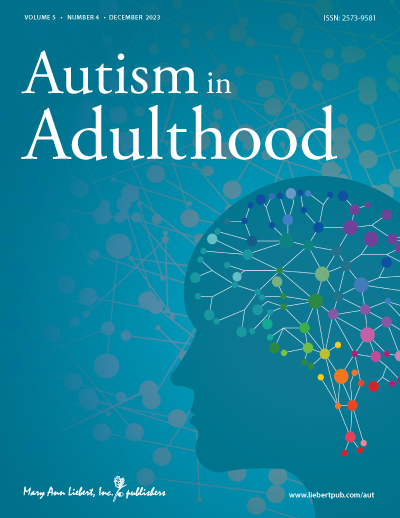“I Wish This Tool Was Available to Me Sooner”: Piloting a Workplace Autism Disclosure Decision-Aid Tool for Autistic Youth and Young Adults
IF 6.8
Q1 PSYCHOLOGY, DEVELOPMENTAL
引用次数: 0
Abstract
Background: For autistic youth and young adults, deciding whether to disclose their autism at work may be complex since they are newly entering the workforce and are at an impressionable developmental period. Decision-aid tools can help someone make a choice regarding a topic/situation. We developed a workplace autism disclosure decision-aid tool called DISCLOSURE (Do I Start the Conversation and Let On, Speak Up, and REveal?) to support autistic youth and young adults navigate disclosure decision-making. In this study, we aimed to assess the DISCLOSURE tool's (1) impact on decision-making and self-determination capabilities and (2) usability, feasibility, and acceptability. Methods: This was a single-arm pre–post pilot study. The DISCLOSURE tool comprises three interactive PDF documents and videos. Thirty participants (mean age of 23.5 years) completed online surveys before and after interacting with the DISCLOSURE tool. We used descriptive statistics for usability, feasibility, and acceptability. We calculated the Wilcoxon signed rank and paired t-tests to determine pre–post changes in decision-making and self-determination capabilities (Decisional Conflict Scale–Low Literacy Version [DCS-LL]; adapted Arc's Self-Determination Scale). We analyzed open-ended data using conventional (inductive) content analysis. Results: There were significant decreases in DCS-LL total and subscale scores (p < 0.0001) and a significant increase in Arc's total score (p = 0.01), suggesting important improvements. There were no significant increases for Arc's psychological empowerment and self-realization subscales (p = 0.05; p = 0.09). Median scores (4.0/5.0) indicate that participants agreed that the DISCLOSURE tool is acceptable, feasible, and meets the usability criteria. We developed four categories to describe the open-ended data: (1) disclosure capabilities, (2) the role of others, (3) positive tool impact and feedback, and (4) minimal tool impact and constructive feedback. Discussion: Findings are suggestive of the DISCLOSURE tool's ability to support workplace autism disclosure decision-making. Future studies should ascertain the DISCLOSURE tool's effectiveness, explore others' feedback (e.g., employers), and how to incorporate the tool into relevant employment and vocational programs. Autistic youth and young adults face a dilemma when starting their first jobs: should they disclose their autism at work? This is a complicated decision and involves considering many factors, benefits, and risks. Our team developed a decision-aid tool to help with this decision-making process called DISCLOSURE (Do I Start the Conversation and Let On, Speak Up and REveaL?). This study is important because it is the first to assess the DISCLOSURE tool and explore if it may be helpful. This study had two main goals. First, we assessed if the DISCLOSURE tool helps to build self-determination and decision-making knowledge, skills, and confidence. Second, we explored if participants thought that the DISCLOSURE tool is usable, acceptable, and can be used in the real world (feasible). We recruited 30 participants (average age of 23.5 years) to complete two online surveys—one before and one after using the DISCLOSURE tool. We analyzed the data to observe if there were changes in decision-making and self-determination knowledge, skills, and confidence. We also explored how participants rated the acceptability, feasibility, and usability of the DISCLOSURE tool. We read through open-ended answers to group them into categories. We found important improvements in participants' decision-making knowledge, skills, and confidence. The DISCLOSURE tool shows promise to improve self-determination. Participants agreed that the DISCLOSURE tool is usable, acceptable, and feasible. Many participants said that the DISCLOSURE tool can help them make disclosure decisions at work. Some participants said that the tool was not as helpful for them. This is because they already had disclosure knowledge and experience. Overall, the study results suggest that the tool may support some autistic young people with the disclosure decision-making process. Few tools exist that support disclosure decision-making. Research also shows that young autistic people find it hard to make autism disclosure decisions at work and may need help. This study is the first to assess a tool that may close important gaps and help autistic young people make disclosure choices. We need to continue testing the DISCLOSURE tool since this is the first time that we assessed it. We also missed some important perspectives in this study. Most participants were white, cisgender women, or nonbinary from Ontario, Canada, and needed internet and a tech device to take part. Results show that the DISCLOSURE tool may help autistic youth and young adults make disclosure choices at work. We will continue to assess the DISCLOSURE tool to make sure it is effective. Autistic youth and young adults could use the DISCLOSURE tool in the future to help guide their disclosure choices at work. Relevant service providers could also use the DISCLOSURE tool with their autistic clients.“我希望我能早点得到这个工具”:为自闭症青年和年轻人试用一个工作场所自闭症披露决策辅助工具
背景:对于自闭症青少年和青壮年来说,由于他们刚进入职场,处于易受影响的发展期,决定是否在工作中披露自己的自闭症可能是一件复杂的事情。决策辅助工具可以帮助人们对一个话题/情况做出选择。我们开发了一种工作场所自闭症披露决策辅助工具,名为disclosure(我是否开始对话,让自己说出来,说出来,揭示出来?),以帮助自闭症青年和年轻人做出披露决策。在本研究中,我们旨在评估披露工具(1)对决策和自决能力的影响,以及(2)可用性、可行性和可接受性。方法:这是一项单臂前-后先导研究。披露工具包括三个交互式PDF文件和视频。30名参与者(平均年龄23.5岁)在与披露工具互动之前和之后完成了在线调查。我们对可用性、可行性和可接受性使用描述性统计。我们计算了Wilcoxon签名秩和配对t检验来确定决策和自决能力的前后变化(决策冲突量表-低识字率版本[DCS-LL];改编自Arc的自决量表)。我们使用传统的(归纳)内容分析来分析开放式数据。结果:两组患者DCS-LL总分和亚量表评分均显著降低(p < 0.0001), Arc总分均显著升高(p = 0.01),均有显著改善。Arc的心理授权和自我实现分量表无显著升高(p = 0.05;P = 0.09)。中位数得分(4.0/5.0)表明参与者同意披露工具是可接受的、可行的,并且符合可用性标准。我们开发了四个类别来描述开放式数据:(1)披露能力,(2)他人的角色,(3)积极的工具影响和反馈,以及(4)最小的工具影响和建设性的反馈。讨论:研究结果暗示了披露工具支持工作场所自闭症披露决策的能力。未来的研究应确定披露工具的有效性,探索他人的反馈(如雇主),以及如何将该工具纳入相关的就业和职业计划。自闭症青年和年轻人在开始他们的第一份工作时面临着一个困境:他们应该在工作中透露自己的自闭症吗?这是一个复杂的决定,需要考虑许多因素、利益和风险。我们的团队开发了一个决策辅助工具来帮助这个决策过程,它被称为DISCLOSURE(我是否应该开始对话并让它继续,说出来并揭示出来?)这项研究很重要,因为它是第一个评估披露工具并探索它是否有用的研究。这项研究有两个主要目标。首先,我们评估了披露工具是否有助于建立自我决定和决策知识、技能和信心。其次,我们探讨了参与者是否认为披露工具是可用的、可接受的,并且可以在现实世界中使用(可行)。我们招募了30名参与者(平均年龄23.5岁)来完成两份在线调查——一份在使用DISCLOSURE工具之前,一份在使用之后。我们分析数据来观察是否有决策和自决知识,技能和信心的变化。我们还探讨了参与者如何评价披露工具的可接受性、可行性和可用性。我们通读开放式的答案,将它们分类。我们发现参与者的决策知识、技能和信心都有了很大的提高。“披露”工具显示出提高自我决定能力的希望。与会者一致认为披露工具是可用的、可接受的和可行的。许多与会者说,披露工具可以帮助他们在工作中作出披露决定。一些参与者表示,该工具对他们没有多大帮助。这是因为他们已经有了披露的知识和经验。总的来说,研究结果表明,该工具可能支持一些自闭症年轻人的披露决策过程。支持信息披露决策的工具很少。研究还表明,年轻的自闭症患者发现很难在工作中做出披露自闭症的决定,可能需要帮助。这项研究首次评估了一种工具,这种工具可能会缩小重要的差距,帮助自闭症年轻人做出披露信息的选择。我们需要继续测试DISCLOSURE工具,因为这是我们第一次对它进行评估。在这项研究中,我们也错过了一些重要的观点。大多数参与者是来自加拿大安大略省的白人、顺性女性或非二元性别,需要互联网和科技设备才能参加。结果表明,该工具可以帮助自闭症青少年和青壮年在工作中做出披露选择。我们将继续评估披露工具以确保其有效性。 自闭症青年和年轻人可以在未来使用披露工具来帮助指导他们在工作中披露的选择。相关的服务提供者也可以对他们的自闭症客户使用披露工具。
本文章由计算机程序翻译,如有差异,请以英文原文为准。
求助全文
约1分钟内获得全文
求助全文

 求助内容:
求助内容: 应助结果提醒方式:
应助结果提醒方式:


